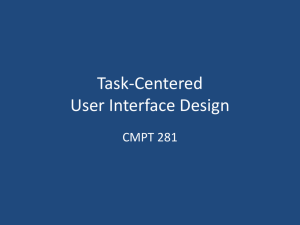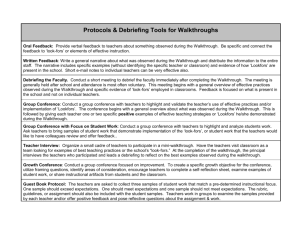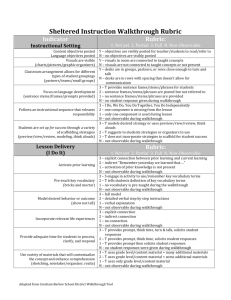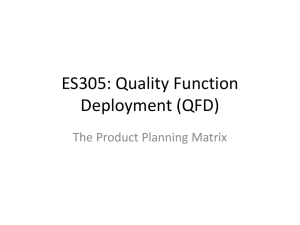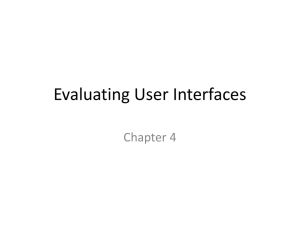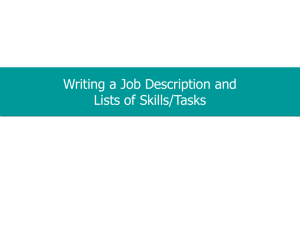Task description 1
advertisement
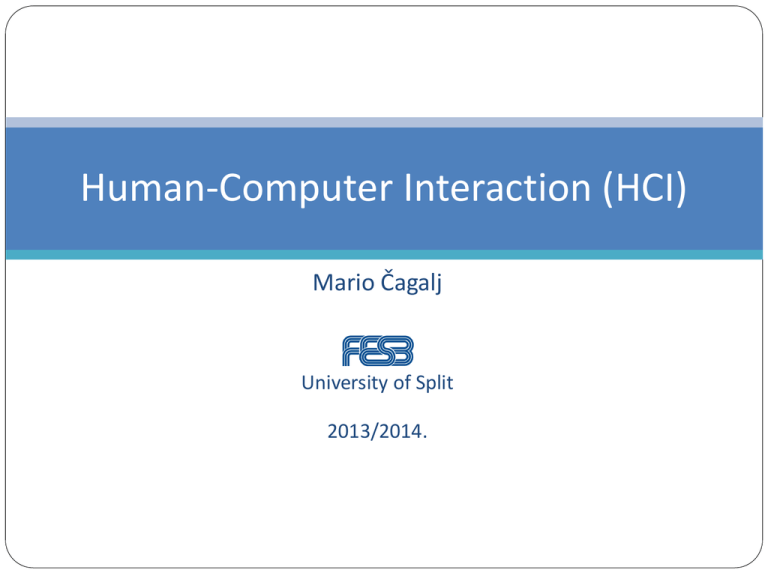
Human-Computer Interaction (HCI) Mario Čagalj University of Split 2013/2014. Task-Centered System Design Based on slides by Saul Greenberg … Seat-of-your-pants interface design Is this a good or bad interface? do you go by gut feel? do you go by how it looks? do you judge it by familiarity to other interfaces? if there are problems, are they minor or serious? did you miss anything that you really shouldn’t have? is your opinion correct? how can you tell? Alternative: are there methods where you can systematically determine if this interface matches the needs of its end users? systematically discover the usability bugs? http://www.usabilitynet.org What is usability? Usability is the measure of the quality of a user's experience when interacting with a product or system The international standard, ISO 9241-11, defines it as: The extent to which a product can be used by specified users to achieve specified goals with effectiveness, efficiency and satisfaction in a specified context of use. Usability is about: Effectiveness - can users achieve goals with the product? Efficiency - how much effort (time) do users require to do this? Satisfaction – what do users think about the products ease of use? ….which are affected by: The users, their goals, the usage situation (or ‘context of use’) Usability should not be confused with ‘functionality‘ Increased functionality does not mean improved usability! 4 Task Centered System Design (TCSD) Highly practical usability engineering methodology Introduced in 1993 by Clayton Lewis and John Rieman Simple to learn and apply TCSD is a process where designers Articulate descriptions of real-world people doing their real-world tasks Use these descriptions to determine which users and what tasks the system should support Prototype an interface that satisfy these requirements Evaluate the interface by performing a task-centered walkthrough 5 An interface design process and usability engineering Goals: Articulate: •who users are •their key tasks Brainstorm designs Task-centered system design Participatory design Methods: Evaluate User-centered design Psychology of everyday things Participatory interaction User involvement Representation & metaphors Task scenario walkthrough low fidelity prototyping methods Products: User and task descriptions Throw-away paper prototypes Refined designs Graphical screen design Interface guidelines Style guides Completed designs Usability testing Field testing Heuristic evaluation high fidelity prototyping methods Testable prototypes Alpha/beta systems or complete specification Note: OmniTouch Working example: Cheap Shop The Cheap Shop Catalog Store In Cheap Shop, people shop by browsing paper catalogs scattered around the store (IKEA). When people see an item they want, they enter its item code from the catalog onto a form. People give this form to a clerk, who brings the item(s) from the back room to the front counter. People then pay for the items they want. Item code Amount Your task Cheap Shop contracts you to evaluate their in-store system prototype Customers would use this system to indicate and buy items System sends this request to the warehouse Screen 1 Screen 2 9 Task Centered System Design (TCSD) Task Centered System Design (TCSD) An end-users perspective Exactly who would use the system to do exactly what? TCSD main phases: Identification identify specific users and articulate their concrete tasks User-Centered Requirements Analysis decide which of these tasks and users the design will support Design base design representation and dialog sequences on these tasks Walkthrough Evaluations using your design, walk through these tasks to test the interface 11 Phase 1: Identify users + tasks Get in touch with real people who will be potential users of your system prototypical categories extremes Learn about their real tasks articulate concrete, detailed examples of tasks they perform or want to perform that your system should support routine infrequent but important infrequent and incidental 12 Phase 1: Identify users + tasks How do you identify tasks? Immerse yourself in a real person’s environment Observe people in their actual work context Interview people as they do their work Example: Ericsson e-Health solution for pharmacy shops Shadow a person over the course of his or her day Serve people’s requests … 13 Phase 1: Identify users + tasks If there are no real users or tasks… think again, there probably are! Jeff Hawkins, the inventor of the Palm Pilot, was said to have carried a small block of wood around in his shirt pocket … As various everyday situations arose, he would take out the block of wood and imagine how he would use the device. The same technique can be used to evoke a response from expected end-users 14 Phase 1: Identify users + tasks If all else fails (no observations nor interviews)… describe your expected set of users, describe your expected set of tasks These will become your ‘assumed users and tasks’ verify them later as information comes in modify them as needed 15 Phase 1: Developing good task descriptions You must write up the results of your observations and interviews. The description follows five important criteria: Says what user wants to do but does not say how they would do it 1. no assumptions made about the interface can be used to compare design alternatives in a fair way Are very specific 2. says exactly what the user wants to do specifies actual items the user would somehow want to input 16 Phase 1: Developing good task descriptions Describes a complete job 3. forces designer to consider how interface features work together contrasts how information input / output flows through the dialog where does information come from? where does it go? what has to happen next? Do not create a list of simple things the system should do present a sub-goal independent of other sub-goals 17 Phase 1: Developing good task descriptions Says who the users are 4. name names, if possible says what they know Why? design success strongly influenced by what users know can go back and ask them questions later reflects real interests of real users helps you find tasks that illustrate functionality in that person’s real work context 18 Phase 1: Developing good task descriptions 5. Are evaluated Circulate descriptions to users, and rewrite if needed ask users for omissions corrections clarifications suggestions 6. As a set, identifies a broad coverage of users and task types the typical ‘expected’ user, the occasional but important user, the unusual user typical routine tasks infrequent but important tasks unexpected or odd tasks 19 Phase 2: Requirements Which user types will be addressed by the interface? designs can rarely handle everyone! includes why particular users are included / excluded Which tasks will be addressed by the interface? designs can rarely handle all tasks requirements listed in terms of how they address tasks Absolutely must include Should include (if budget and time permits) Could include (if can be included almost ‘for free’) Exclude (unimportant) discussion includes why items are in those categories Rule of thumb: 90% coverage, i.e., 90% of the people can do 90% of the tasks reasonably well 20 Phase 3: Design through Scenarios Develop designs to fit users and specific tasks ground interfaces in reality Use tasks to get specific about possible designs consider the real world contexts of real users consider how design features work together what would the user do / see step-by-step when performing this task? 21 Phase 4: Walk-through Evaluation You choose scenario and perform task centered walkthrough of it Good for debugging an interface No need for end-user involvement (do it yourself or better with your team) Put yourself in the mind and context of the end user Lewis and Rheiman’s walkthrough algorithm Select one of the task scenarios For each user’s step/action in the task: 1. 2. can you build a believable story that motivates the user’s actions? can you rely on user’s expected knowledge and training about system? if you cannot: a) b) c) 3. you’ve located a problem in the interface! note the problem, including any comments assume it has been repaired go to the next step in the task 22 An interface design process and usability engineering Goals: Articulate: •who users are •their key tasks Brainstorm designs Task-centered system design Participatory design Methods: Evaluate User-centered design Psychology of everyday things Participatory interaction User involvement Representation & metaphors Task scenario walkthrough low fidelity prototyping methods Products: User and task descriptions Throw-away paper prototypes Refined designs Graphical screen design Interface guidelines Style guides Completed designs Usability testing Field testing Heuristic evaluation high fidelity prototyping methods Testable prototypes Alpha/beta systems or complete specification Working example: Cheap Shop The Cheap Shop Catalog Store In Cheap Shop, people shop by browsing paper catalogs scattered around the store (IKEA). When people see an item they want, they enter its item code from the catalog onto a form. People give this form to a clerk, who brings the item(s) from the back room to the front counter. People then pay for the items they want. Item code Amount Your task If the prototype has major problems Screen 1 Cheap Shop contracts you to evaluate their in-store system prototype Customers would use this system to indicate and buy items System sends this request to the warehouse Suggest changes (to repair) Screen 2 Proposa a new design 26 The Cheap Shop Prototype Specifications To order the first item: shoppers follow sequence on screen 1 to enter their personal information and their first order; text is entered via keyboard, and the tab or mouse is used to go between fields. To order additional items: shoppers fill in screen 2 after clicking Next Catalog Item (can be repeated). To complete an order: shoppers click Trigger Invoice; the system automatically tells shipping and billing about the order; the system returns to a blank screen #1. To cancel the order: shoppers do not enter input for 30 seconds (as if they walk away); the system will then clear all screens and return to the main screen. Input checking: all input fields checked when either button is pressed; erroneous fields will blink for 3 seconds, and will then be cleared; the shopper can then re-enter the correct values in those fields. 27 Developing task descriptions Task description 1 Fred Johnson, who is caring for his demanding toddler son, wants a good quality umbrella stroller (red is preferred, but blue is acceptable). He browses the catalog and chooses the JPG stroller (cost $98. item code 323 066 697). He pays for it in cash, and uses it immediately. Fred is a first-time customer to this store, has little computer experience, and says he types very slowly with one finger. He lives nearby on Dear Bottom Avenue NW. JPG Stroller. This well made but affordable Canadian stroller fits children between 1-3 years old. Its wheels roll well in light snow and mud. …$98. Red: Blue: 323 066 697 323 066 698 28 Developing task descriptions Discussion Fred has many properties of our typical expected user: many customers are first time shoppers, a good number have no computer experience a good number are poor typists. The task type is routine and important. many people often purchase only one item a good number of those pay by cash as with Fred, people often have a general sense of what they want to buy, but decide on the actual product only after seeing what is available. 29 Developing task descriptions Task description 2 Mary Vornushia is price-comparing the costs of a child’s bedroom set, consisting of a wooden desk, a chair, a single bed, a mattress, a bedspread, and a pillow all made by Furnons Inc. She takes the description and total cost away with her to check against other stores. Three hours later, she returns and decides to buy everything but the chair. She pays by credit card. She asks for the items to be delivered to her daughter’s home at 31247 Lucinda Drive, in the basement suite at the back of the house. Mary is elderly and arthritic. 30 Developing task descriptions Discussion Like Mary, a reasonable number of store customers are elderly, with infirmities that inhibit their physical abilities. a modest number of them also enjoy comparison shopping, perhaps because they have more time on their hands or because they are on low income. The task type is less frequent, but still important. although this would be considered a ‘major’ purchase in terms of the total cost, the number of items purchased is not unusual. delivery of large items is the norm most customers pay by credit card for larger orders. 31 Developing task descriptions Task description 3 John Forham, the sole salesperson in the store, is given a list of 10 items by a customer who does not want to use the computer. The items are: 4 pine chairs, 1 pine table, 6 blue place mats, 6 “lor” forks, 6 “lor” table spoons, 6 “lor” teaspoons, 6 “lor” knives, 1 “tot” tricycle, 1 red ball, 1 “silva” croquet set After seeing the total, the customer tells John he will take all but the silverware The customer then decides to add 1 blue ball to the list. The customer starts paying by credit card, but then decides to pay cash. The customer tells John he wants the items delivered to his home the day after tomorrow. While this is occurring, 6 other customers are waiting for John. John has been on staff for 1 week, and is only partway through his training program 32 Developing task descriptions Discussion This task introduces the clerk as a system user. Because the store has a high turnover in its staff, new employees such as John are also common. Thus John reflects a ‘rare’ but important group of users. The task type is less frequent, but still important The task, while complex, is fairly typical i.e., people making large numbers of purchases often ask the clerk to help them. Similarly, clerks mention that customers often change their mind partway through a transaction i.e., by changing what they want to buy and/or by changing how they want to pay for it. Customers, however, rarely give specific delivery dates, with most wanting delivery as soon as possible. Lineups for clerks are common during busy times. 33 Cheap Shop prototype Cheap Shop already have an interface in hand we begin by performing a Screen 2 Screen 1 task centered walkthrough of it our walkthrough analysis done with a scenario that combines our initial task descriptions with this interface 34 The Cheap Shop Prototype Specifications To order the first item: shoppers follow sequence on screen 1 to enter their personal information and their first order; text is entered via keyboard, and the tab or mouse is used to go between fields. To order additional items: shoppers fill in screen 2 after clicking Next Catalog Item (can be repeated). To complete an order: shoppers click Trigger Invoice; the system automatically tells shipping and billing about the order; the system returns to a blank screen #1. To cancel the order: shoppers do not enter input for 30 seconds (as if they walk away); the system will then clear all screens and return to the main screen. Input checking: all input fields checked when either button is pressed; erroneous fields will blink for 3 seconds, and will then be cleared; the shopper can then re-enter the correct values in those fields. 35 Walkthrough template Description of Step Does the user have the knowledge/training to do this? Is it believable that they would do it? Are they motivated? Task number: ____ Comment / solution A walkthrough for this exercise is found in Greenberg, S. “Working through Task-Centered System Design. in Diaper, D. and Stanton, N. (Eds) The Handbook of Task Analysis for Human-Computer Interaction. Lawrence Erlbaum Associates. Walkthrough: First task (Fred) Interface: Cheap Shop prototype #1. Description #1. Fred Johnson, who is caring for his demanding toddler son, wants a good quality umbrella stroller (red is preferred, but blue is acceptable). He browsers the catalog and chooses the JPG stroller (cost $98., item code 323 066 697). He pays for it in cash, and uses it immediately. Fred is a first-time customer to this store, has little computer experience, and says he types very slowly with one finger. 37 Walkthrough: First task (Fred) - Table 1 38 Walkthrough: First task (Fred) - Table 2 39 Walkthrough: First task (Fred) - Table 2 40 Walkthrough: First task (Fred) - Table 2 41 Walkthrough: First task (Fred) - Table 3 42 Walkthrough: First task (Fred) - Table 3 43 Walkthrough: First task (Fred) - Table 4 44 Walkthrough: First task (Fred) - Table 5 45 Walkthrough example While Tables 1-5 appear detailed, they do not cover all task steps some left out as they are identical to previously seen task steps some simple forgotten (not thought about) – videotape or larger team The other two descriptions yield other problems Task 2 (Mary) cannot use the mouse or type because she is arthritic when multiple items are ordered; the system gives no feedback of what was entered there is no way to correct errors without re-entering everything from scratch there is also no easy way for Mary to price-compare (since no printout is provided) there is no easy way for her to tell the system about the unusual delivery address (i.e., that it is the basement in the back) Task description 3 (John) the system prototype completely unsuitable for use by the store clerk (too slow, this affects customers waiting in line, the system cannot accomodate delayed delivery) All in all, this design is disaster 46 Redesigning the interface - phase 2 According to the task centered process, we have gone successfully through phase 1 identified users + tasks, come up with the tasks descriptions in the next phase (phase 2: user-centered requirements) we make decision on which users and tasks should be supported to do this, we split the main user types and tasks in the following categories 47 Redesigning the interface - phase 3 According to the task centered process, in phase 3 by building on the previous requirements and our knowledge of the problems detected in our walkthrough, we prototype our interface partial wizard approach to tasks prototyped several different ways paper - 45 minutes scripted animation - 2 hours 48 Printing… To recall this order, scan the bar code on the printout Your task Does it work? do a task-centered walkthrough to find out! 54 Goal-centered system design Articulate user goals instead of task sequences Goal: a desired end condition tend to be stable Task: an intermediate process needed to achieve the goal may change as technology / work patterns change See Allan Cooper ‘The inmates are running the asylum’, Sams (Macmillan), especially Chapter 9 and 11. Goal-centered system design Designer looking for solutions that satisfy these goals task sequence may differ substantially from current process Approach: Develop a persona precise, specific description of the user and the goal they wish to accomplish a pretend user that are hypothetical archetypes of actual users discovered as a by-product of investigating the problem domain Develop a cast of characters 3 – 12 unique personas one will be the primary persona – the main focus of the design Concluding words Task-centered design and prototyping first step in an iterative user centered system design offers big ‘bang for the buck’ not perfct (more precise techniques exist) not to be used for air traffic control system for non-critical systems under a limited budget User centered system design not academic process where some book formula can be applied it is a hands-on process that requires you to go out and identify actual users, talk to them about what tasks they are trying to do, and understand the entire context of their work you then base your designs on this information you will have to identify potential usability problems by continually evaluating your design (iterative design) 57 You know now How to develop concrete task examples How to use task examples to motivate your designs How to evaluate designs through task-centered walkthroughs An interface design process and usability engineering Goals: Articulate: •who users are •their key tasks Brainstorm designs Task-centered system design Participatory design Methods: Evaluate User-centered design Psychology of everyday things Participatory interaction User involvement Representation & metaphors Task scenario walkthrough low fidelity prototyping methods Products: User and task descriptions Throw-away paper prototypes Refined designs Graphical screen design Interface guidelines Style guides Completed designs Usability testing Field testing Heuristic evaluation high fidelity prototyping methods Testable prototypes Alpha/beta systems or complete specification
